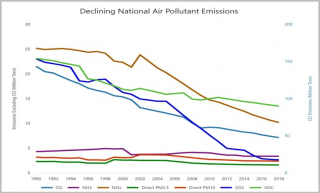
On November 15, 1990, the Clean Air Act was revised to curb four major threats to the environment and to the health of millions of Americans: acid rain, urban air pollution, toxic air emissions, and stratospheric ozone depletion. The amendments also established a national operating permits program and strengthened enforcement to help ensure better compliance with the Act.
The Clean Air Excellence Awards Program periodically recognizes and honors outstanding innovative efforts to help make progress in achieving cleaner air. Explore the Clean Air Excellence Awards
Despite dramatic progress cleaning the air since 1970, air pollution in the United States continues to harm people’s health and the environment. Read about the challenges
The Act calls for states and EPA to solve multiple air pollution problems through programs based on the latest science and technology information.
Congress designed the Clean Air Act to combat a variety of air pollution problems, and to tackle emerging pollution threats.
The Clean Air Act calls for state, local, tribal and federal governments to work in partnership to clean the air.
Under the Act, EPA seeks to provide industry with flexibility on ways to control emissions while maintaining accountability for achieving reductions.
Under the Clean Air Act, health-based air quality standards are based on the latest science. Emissions standards for sources are based on information about available technologies.
Stakeholders and the public play critical roles in developing standards and implementation of the Clean Air Act.
Over 40 years of experience with the Clean Air Act shows that clean air and a healthy economy can go hand in hand.
Actions to implement the Clean Air Act have achieved dramatic reductions in air pollution, preventing hundreds of thousands of cases of serious health effects each year.

Since 1990 there has been approximately a 50% dec line emissions of key air pollutants .